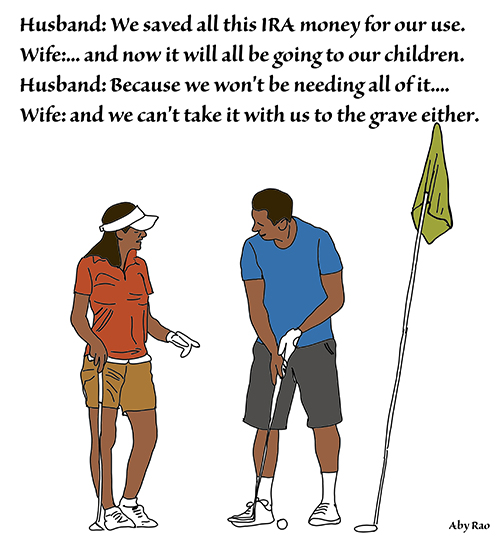
We all should have our own IRAs for our retirement purposes. And we faithfully and seriously contribute to it under the auspices of what is allowed by law. Then there are 401Ks, which eventually get converted to IRAs, and together it becomes a reasonably sizeable pool of assets to be enjoyed in our retirement. So far so good.
After we quit working, or even before that, but without getting penalized, we start withdrawing from these accounts. After a certain age the IRS tells you, or more like forces you, to take a minimum withdrawal (called RMD) from your retirement accounts. I think most of us know this drill or will be accustomed to it shortly.
For many, these retirement accounts grow well and they are not able to exhaust their accounts in their lifetimes; which means that there is actually substantial money left in that account at the time of their death. So, what happens to all that money? Nothing to worry; IRS has made provisions for it. They insist that you have beneficiaries named in your custodial IRA account so that there is a clear pathway as to how the money will be disposed from your account when you are not there and the account becomes orphan. The first step in this regard is that the money will go to the surviving spouse and that is an easy process as written in the estate laws of this country and those of each State. It is the disposition of this account after the demise of the spouse is what I am most concerned with. That disposition needs to be handled carefully and we all need to be aware there are traps that we can easily fall into.
The first trap: Are there beneficiaries named to the account and is it clear what percentage of your account will be inherited by them? You have to make sure that the banks follow this procedure. Having well defined beneficiaries to all your accounts is a must and you should insist on it. For IRAs generally it is children who inherit after both parents have died. If it is not equal distribution then the exact percentages must be specified.
Second trap: On the beneficiary form it is important to have a contingent or per stirpes designated beneficiary named to allow more flexibility. It is possible that the first beneficiary pre-deceases the IRA owner and the beneficiary form was not updated. It is also possible that the first beneficiary, for whatever reasons, may decline to accept the IRA money. It used to be that an individual named as beneficiary could extend the required minimum distributions over his or her lifetime known as the stretch IRA. Now the new Law just passed by congress in December 2019 (called SECURE) limits that lifetime stretch down to 10 years in most cases; we will talk more about this in a few months in when I will be writing specifically about that law.

However, whether lifetime or 10-year Stretch, nothing protects those funds from being squandered. Granted the new owner has to pay taxes at his/her own tax rate before the money can be withdrawn but it is still there for squandering if so desired. There is an RMD on this account for the beneficiary but more money can always be withdrawn and empty the account when they wish, just like many lottery winners do. Ever wondered why more than 50 percent of the lottery winners have lost all their money in a few years and actually are on the brink of bankruptcy?
Third trap: it is extremely important that the inherited IRA is set up correctly. The Institutions or Certified Financial Planner you would be working with know that after death, no funds should be removed from the decedent’s IRA until a properly titled IRA is set-up for the one inheriting. The new account should be titled as an inherited IRA. Before any funds are moved, the account should be retitled keeping the name of the deceased IRA owner on the account and adding the beneficiary’s name to the title. An example of a properly titled inherited IRA is: John White IRA, deceased (give a date), f/b/o Jack or Jill White (son or daughter’s name), beneficiary.
If there are multiple beneficiaries, then each beneficiary’s share should be set-up as a separate inherited IRA. The split must be done as a direct transfer and the split must be done by the end of the year after death.
Fourth trap: No contributions. The IRA beneficiaries should know that this is an inherited IRA and not their own IRA. They cannot make contributions to this account; only withdraw per the rules. If they do contribute, they are deemed to have treated the account as their own and the entire account becomes subject to taxation and must be emptied. An inherited ROTH IRA may not be taxable but is also treated the same way.
Fifth trap: Move inherited funds correctly. Inherited IRA funds can only be moved as direct transfers. A non-spouse beneficiary (like a child) can never do a rollover. If the funds are withdrawn as opposed to a direct transfer, they become subject to taxation and cannot be rolled over. Worst part is that such mistake cannot be corrected; there is no recourse.
Sixth trap: Taking correct RMD. The 50 percent penalty for not taking correct RMD also applies to inherited IRAs. The RMD is calculated the same way as the original owner; except it will be calculated for the age of the new owner using the appropriate IRS tables.
There you have it folks. Walk this minefield carefully.
———
Mo Vidwans is an independent, board-certified financial planner. For details visit www.vidwansfinancial.com, call +1 (984) 888-0355 or write to mpvidwans@yahoo.com.



